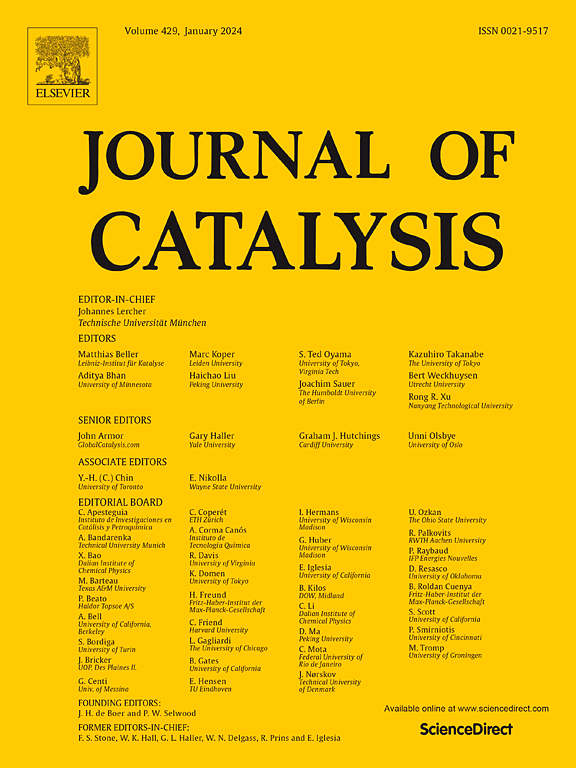Using machine learning to guide the synthesis of supported palladium catalysts with desired palladium dispersion
IF 6.5
1区 化学
Q2 CHEMISTRY, PHYSICAL
引用次数: 0
Abstract
Supported palladium catalysts are indispensable in a wide range of industries, including petrochemicals, pharmaceuticals, and the automotive sector. The dispersion of palladium within these catalysts, primarily determined by the average nanoparticle size, significantly influences both the catalytic properties and the utilization efficiency of palladium. This study explores the relationships between various catalyst synthesis parameters and the resulting Pd nanoparticle size/dispersion. We developed a machine learning (ML) model to guide future synthesis efforts aimed at achieving specific palladium dispersion levels. Data were collected from previous studies on supported Pd catalysts published between 2000 and 2023, encompassing 1543 distinct catalysts. Of these, 1295 data points were used to construct the ML model. Key synthesis parameters—such as synthesis method, metal loading, support type, support surface area, metal precursor, solvent, solvent pH, support’s point of zero charge, and calcination/reduction conditions—were identified as independent variables, while dispersion and average Pd nanoparticle size served as dependent variables. A random forest (RF) regression model was employed to predict dispersion (in %), validated through 5-fold cross-validation. The model achieved root mean squared errors (RMSE) of 9.5 (training) and 14.9 (testing) in Pd dispersion (in %) prediction. Experimental synthesis of new supported palladium catalysts using different synthesis parameters confirmed the model’s predictions, yielding an RMSE of 5.4. Additionally, data from the literature published in 2024 were also used to validate the model, the comparison resulted in an RMSE of 5.9. This ML approach offers significant potential for precisely controlling palladium dispersion during catalyst synthesis, moving beyond traditional trial-and-error methods. It holds a broad potential to significantly improve palladium utilization across a variety of industrial applications.


使用机器学习来指导合成具有理想钯分散的负载钯催化剂
负载型钯催化剂在包括石油化工、制药和汽车行业在内的广泛行业中是不可或缺的。钯在这些催化剂中的分散程度主要由平均纳米颗粒大小决定,这对钯的催化性能和利用效率都有显著影响。本研究探讨了不同催化剂合成参数与钯纳米颗粒尺寸/分散之间的关系。我们开发了一个机器学习(ML)模型来指导未来的合成工作,旨在实现特定的钯分散水平。数据收集自2000年至2023年间发表的关于负载型钯催化剂的先前研究,包括1543种不同的催化剂。其中,1295个数据点用于构建ML模型。将合成方法、金属负载、载体类型、载体表面积、金属前驱体、溶剂、溶剂pH、载体零电荷点、煅烧/还原条件等关键合成参数作为自变量,将分散度和平均钯纳米颗粒尺寸作为因变量。随机森林(RF)回归模型用于预测离散度(in %),并通过5次交叉验证进行验证。该模型在Pd离散度(%)预测中实现了9.5(训练)和14.9(测试)的均方根误差(RMSE)。使用不同合成参数的新型负载型钯催化剂的实验合成证实了该模型的预测,RMSE为5.4。此外,还使用了2024年发表的文献数据来验证模型,比较得出的均方根误差为5.9。这种ML方法为催化剂合成过程中精确控制钯分散提供了巨大的潜力,超越了传统的试错方法。它具有广泛的潜力,可以显著提高钯在各种工业应用中的利用率。
本文章由计算机程序翻译,如有差异,请以英文原文为准。
求助全文
约1分钟内获得全文
求助全文
来源期刊

Journal of Catalysis
工程技术-工程:化工
CiteScore
12.30
自引率
5.50%
发文量
447
审稿时长
31 days
期刊介绍:
The Journal of Catalysis publishes scholarly articles on both heterogeneous and homogeneous catalysis, covering a wide range of chemical transformations. These include various types of catalysis, such as those mediated by photons, plasmons, and electrons. The focus of the studies is to understand the relationship between catalytic function and the underlying chemical properties of surfaces and metal complexes.
The articles in the journal offer innovative concepts and explore the synthesis and kinetics of inorganic solids and homogeneous complexes. Furthermore, they discuss spectroscopic techniques for characterizing catalysts, investigate the interaction of probes and reacting species with catalysts, and employ theoretical methods.
The research presented in the journal should have direct relevance to the field of catalytic processes, addressing either fundamental aspects or applications of catalysis.
 求助内容:
求助内容: 应助结果提醒方式:
应助结果提醒方式:


